Analysis of Food Production and Service in Restaurants
VerifiedAdded on 2023/01/12
|6
|1208
|31
Essay
AI Summary
This essay provides a comprehensive overview of food and beverage operations management, exploring various food production systems such as conventional, centralized, cook and chill, and sous vide methods. It then delves into different food and beverage service methods, including English, American, Butler, and Buffet services. The essay further analyzes food production control, emphasizing the importance of standard recipes, portion control, waste reduction, and volume forecasting. It underscores the significance of these elements in ensuring effective quality management and minimizing operational inefficiencies within the food and beverage industry, highlighting the importance of planning and control for success.
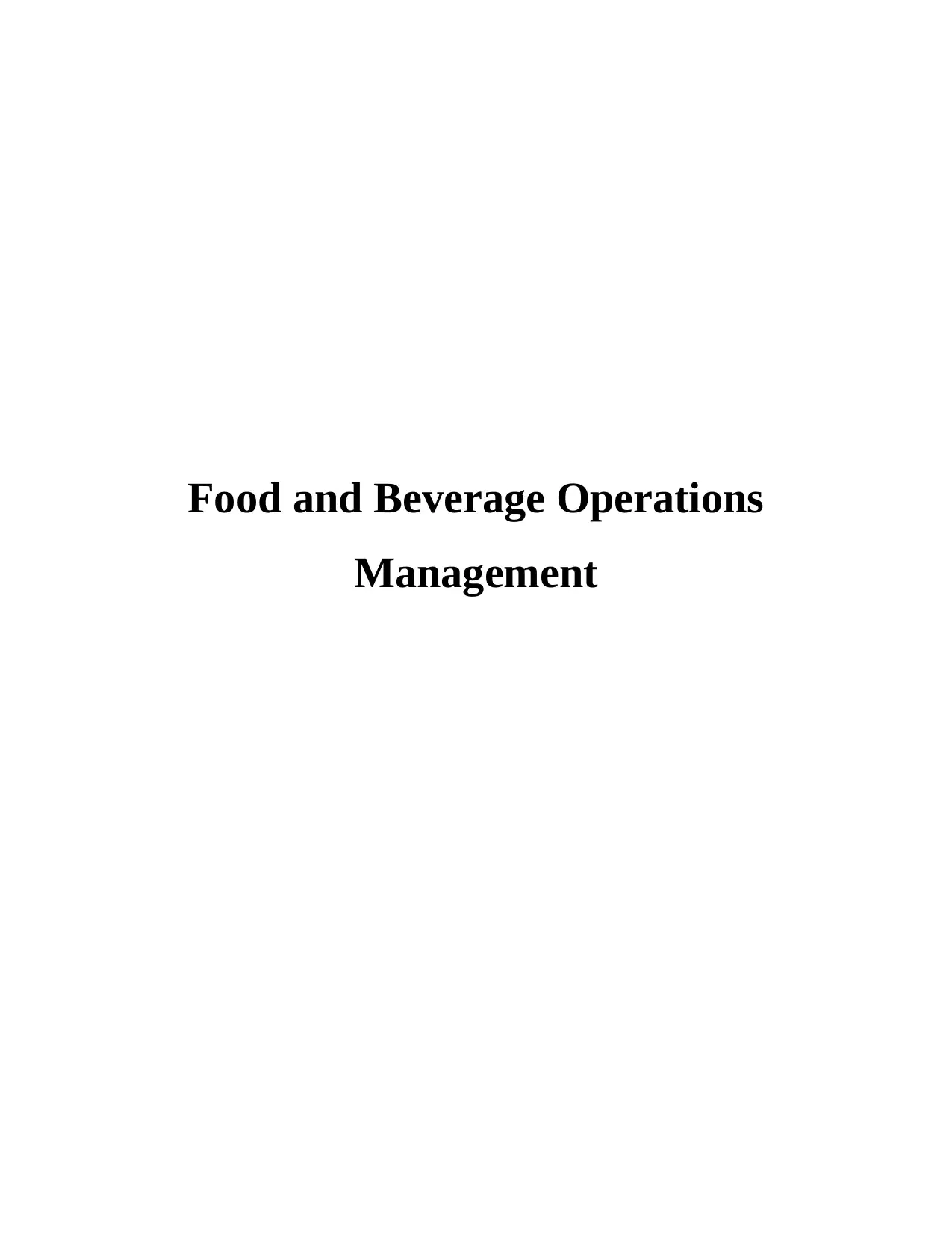
Food and Beverage Operations
Management
Management
Paraphrase This Document
Need a fresh take? Get an instant paraphrase of this document with our AI Paraphraser
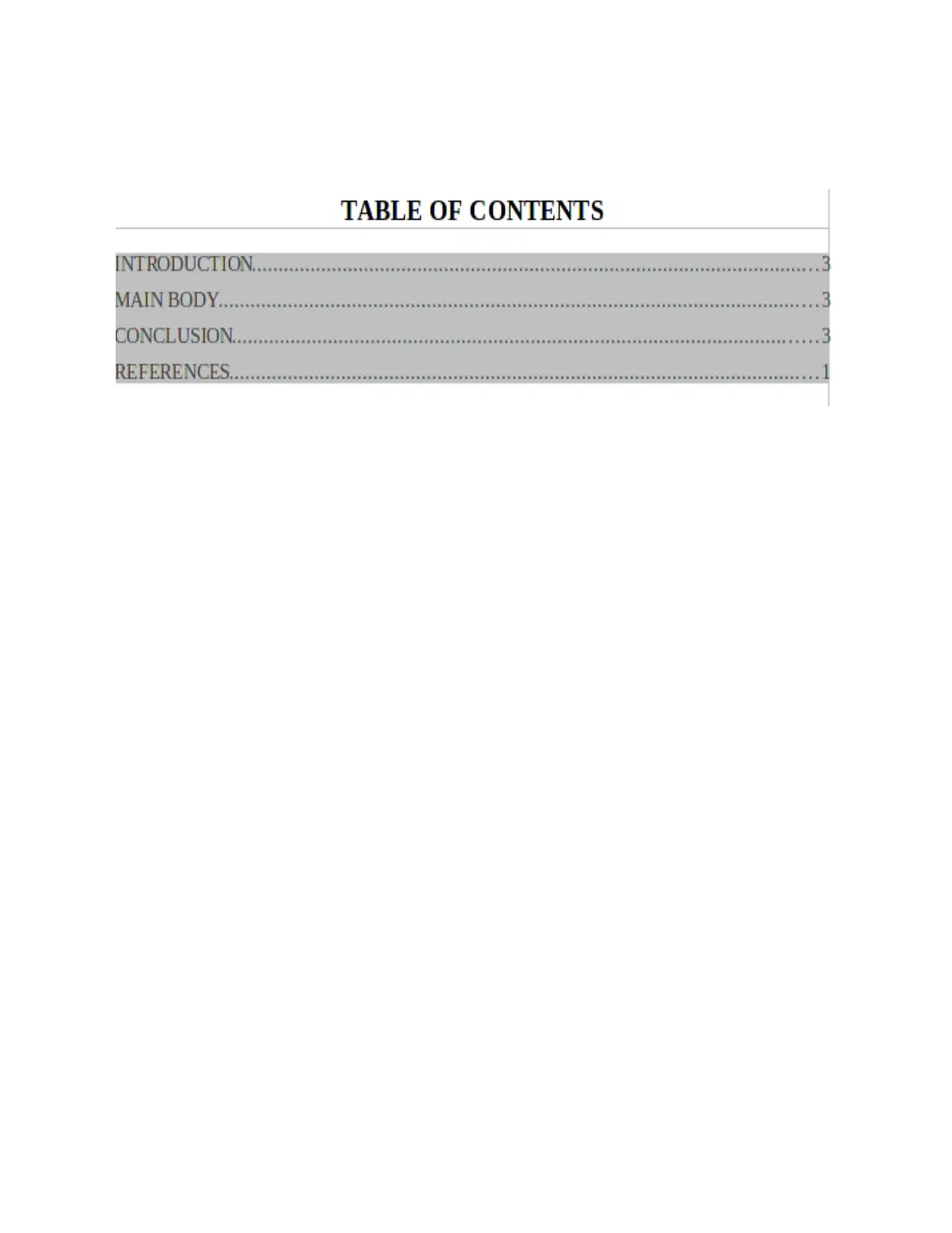
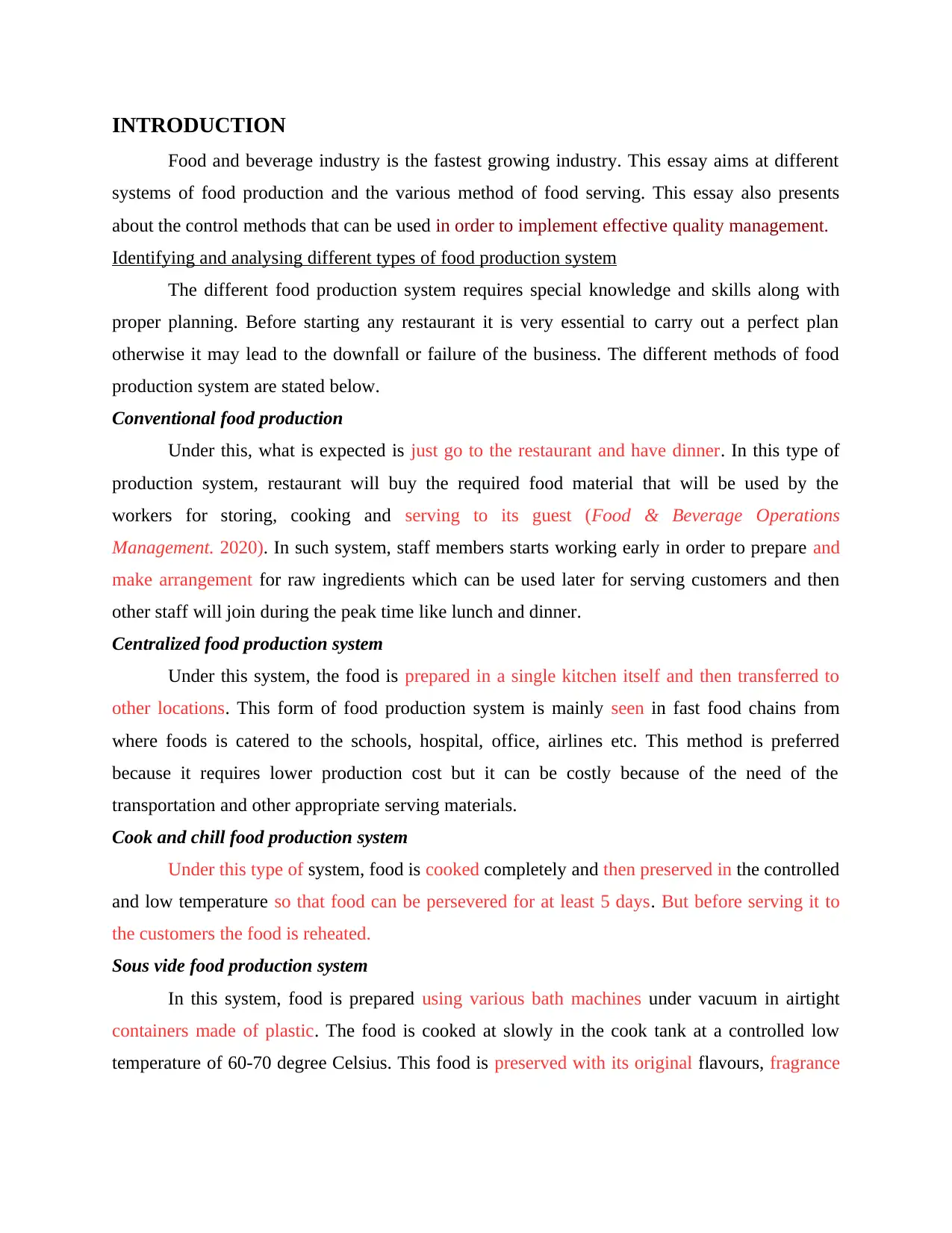
INTRODUCTION
Food and beverage industry is the fastest growing industry. This essay aims at different
systems of food production and the various method of food serving. This essay also presents
about the control methods that can be used in order to implement effective quality management.
Identifying and analysing different types of food production system
The different food production system requires special knowledge and skills along with
proper planning. Before starting any restaurant it is very essential to carry out a perfect plan
otherwise it may lead to the downfall or failure of the business. The different methods of food
production system are stated below.
Conventional food production
Under this, what is expected is just go to the restaurant and have dinner. In this type of
production system, restaurant will buy the required food material that will be used by the
workers for storing, cooking and serving to its guest (Food & Beverage Operations
Management. 2020). In such system, staff members starts working early in order to prepare and
make arrangement for raw ingredients which can be used later for serving customers and then
other staff will join during the peak time like lunch and dinner.
Centralized food production system
Under this system, the food is prepared in a single kitchen itself and then transferred to
other locations. This form of food production system is mainly seen in fast food chains from
where foods is catered to the schools, hospital, office, airlines etc. This method is preferred
because it requires lower production cost but it can be costly because of the need of the
transportation and other appropriate serving materials.
Cook and chill food production system
Under this type of system, food is cooked completely and then preserved in the controlled
and low temperature so that food can be persevered for at least 5 days. But before serving it to
the customers the food is reheated.
Sous vide food production system
In this system, food is prepared using various bath machines under vacuum in airtight
containers made of plastic. The food is cooked at slowly in the cook tank at a controlled low
temperature of 60-70 degree Celsius. This food is preserved with its original flavours, fragrance
Food and beverage industry is the fastest growing industry. This essay aims at different
systems of food production and the various method of food serving. This essay also presents
about the control methods that can be used in order to implement effective quality management.
Identifying and analysing different types of food production system
The different food production system requires special knowledge and skills along with
proper planning. Before starting any restaurant it is very essential to carry out a perfect plan
otherwise it may lead to the downfall or failure of the business. The different methods of food
production system are stated below.
Conventional food production
Under this, what is expected is just go to the restaurant and have dinner. In this type of
production system, restaurant will buy the required food material that will be used by the
workers for storing, cooking and serving to its guest (Food & Beverage Operations
Management. 2020). In such system, staff members starts working early in order to prepare and
make arrangement for raw ingredients which can be used later for serving customers and then
other staff will join during the peak time like lunch and dinner.
Centralized food production system
Under this system, the food is prepared in a single kitchen itself and then transferred to
other locations. This form of food production system is mainly seen in fast food chains from
where foods is catered to the schools, hospital, office, airlines etc. This method is preferred
because it requires lower production cost but it can be costly because of the need of the
transportation and other appropriate serving materials.
Cook and chill food production system
Under this type of system, food is cooked completely and then preserved in the controlled
and low temperature so that food can be persevered for at least 5 days. But before serving it to
the customers the food is reheated.
Sous vide food production system
In this system, food is prepared using various bath machines under vacuum in airtight
containers made of plastic. The food is cooked at slowly in the cook tank at a controlled low
temperature of 60-70 degree Celsius. This food is preserved with its original flavours, fragrance
⊘ This is a preview!⊘
Do you want full access?
Subscribe today to unlock all pages.

Trusted by 1+ million students worldwide
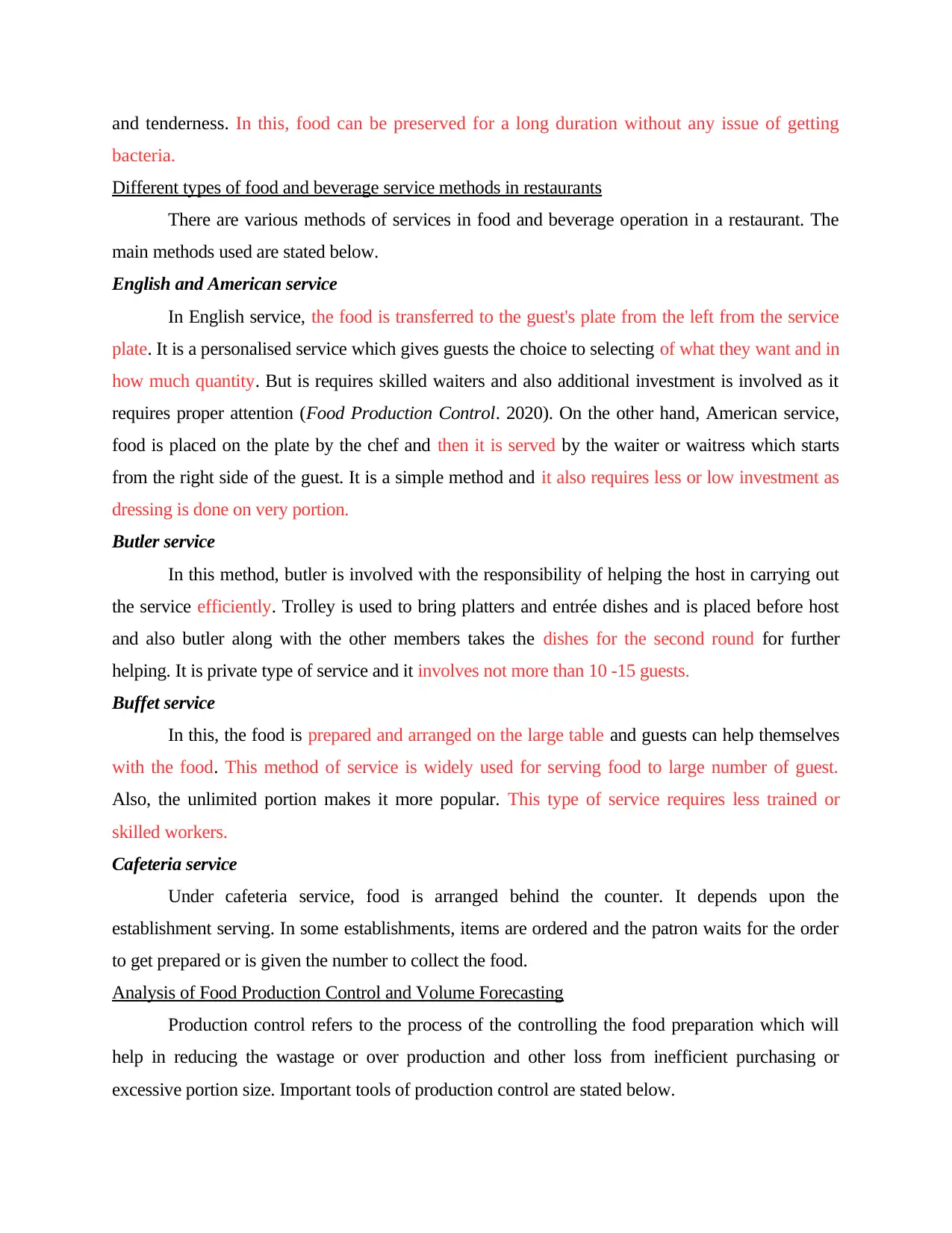
and tenderness. In this, food can be preserved for a long duration without any issue of getting
bacteria.
Different types of food and beverage service methods in restaurants
There are various methods of services in food and beverage operation in a restaurant. The
main methods used are stated below.
English and American service
In English service, the food is transferred to the guest's plate from the left from the service
plate. It is a personalised service which gives guests the choice to selecting of what they want and in
how much quantity. But is requires skilled waiters and also additional investment is involved as it
requires proper attention (Food Production Control. 2020). On the other hand, American service,
food is placed on the plate by the chef and then it is served by the waiter or waitress which starts
from the right side of the guest. It is a simple method and it also requires less or low investment as
dressing is done on very portion.
Butler service
In this method, butler is involved with the responsibility of helping the host in carrying out
the service efficiently. Trolley is used to bring platters and entrée dishes and is placed before host
and also butler along with the other members takes the dishes for the second round for further
helping. It is private type of service and it involves not more than 10 -15 guests.
Buffet service
In this, the food is prepared and arranged on the large table and guests can help themselves
with the food. This method of service is widely used for serving food to large number of guest.
Also, the unlimited portion makes it more popular. This type of service requires less trained or
skilled workers.
Cafeteria service
Under cafeteria service, food is arranged behind the counter. It depends upon the
establishment serving. In some establishments, items are ordered and the patron waits for the order
to get prepared or is given the number to collect the food.
Analysis of Food Production Control and Volume Forecasting
Production control refers to the process of the controlling the food preparation which will
help in reducing the wastage or over production and other loss from inefficient purchasing or
excessive portion size. Important tools of production control are stated below.
bacteria.
Different types of food and beverage service methods in restaurants
There are various methods of services in food and beverage operation in a restaurant. The
main methods used are stated below.
English and American service
In English service, the food is transferred to the guest's plate from the left from the service
plate. It is a personalised service which gives guests the choice to selecting of what they want and in
how much quantity. But is requires skilled waiters and also additional investment is involved as it
requires proper attention (Food Production Control. 2020). On the other hand, American service,
food is placed on the plate by the chef and then it is served by the waiter or waitress which starts
from the right side of the guest. It is a simple method and it also requires less or low investment as
dressing is done on very portion.
Butler service
In this method, butler is involved with the responsibility of helping the host in carrying out
the service efficiently. Trolley is used to bring platters and entrée dishes and is placed before host
and also butler along with the other members takes the dishes for the second round for further
helping. It is private type of service and it involves not more than 10 -15 guests.
Buffet service
In this, the food is prepared and arranged on the large table and guests can help themselves
with the food. This method of service is widely used for serving food to large number of guest.
Also, the unlimited portion makes it more popular. This type of service requires less trained or
skilled workers.
Cafeteria service
Under cafeteria service, food is arranged behind the counter. It depends upon the
establishment serving. In some establishments, items are ordered and the patron waits for the order
to get prepared or is given the number to collect the food.
Analysis of Food Production Control and Volume Forecasting
Production control refers to the process of the controlling the food preparation which will
help in reducing the wastage or over production and other loss from inefficient purchasing or
excessive portion size. Important tools of production control are stated below.
Paraphrase This Document
Need a fresh take? Get an instant paraphrase of this document with our AI Paraphraser
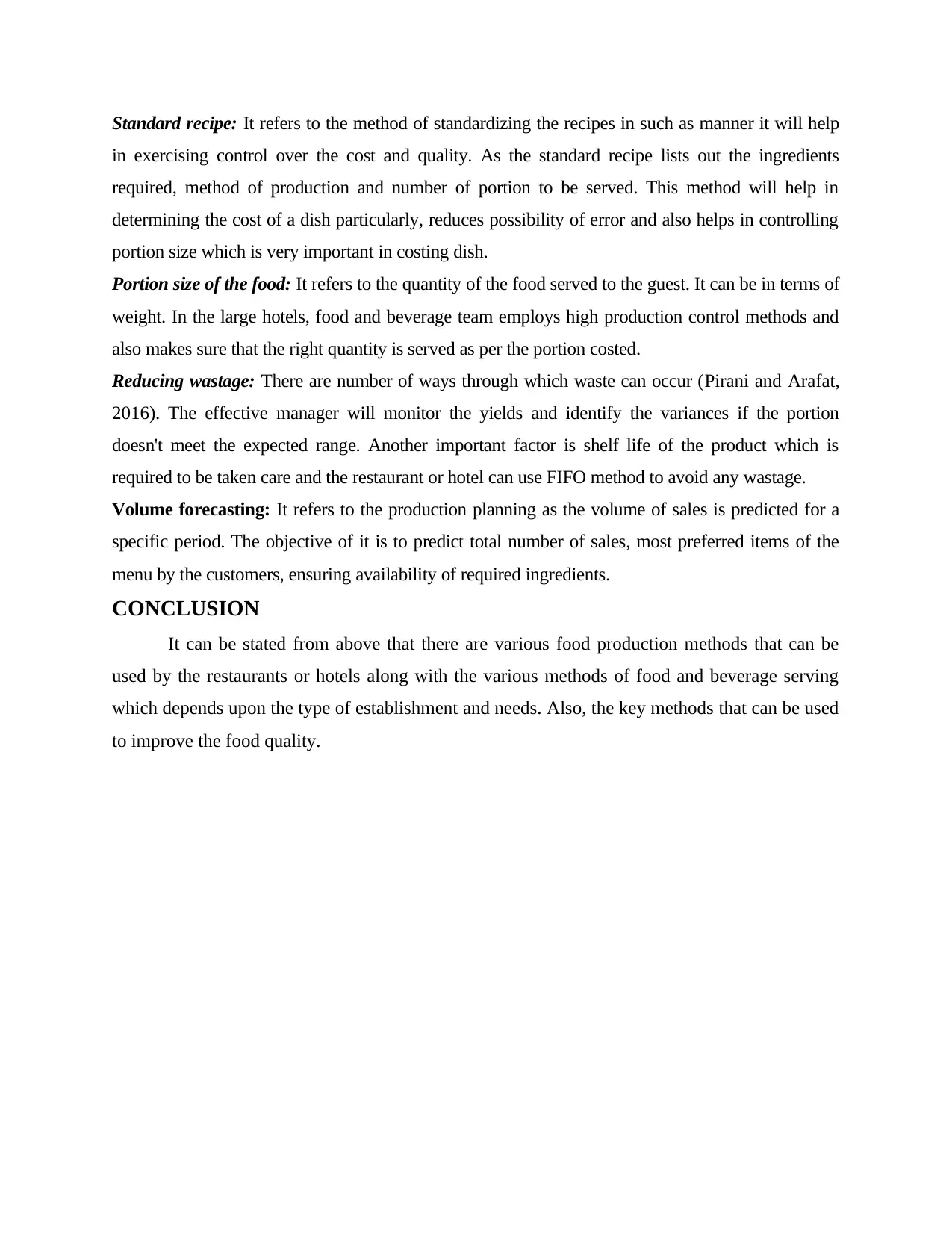
Standard recipe: It refers to the method of standardizing the recipes in such as manner it will help
in exercising control over the cost and quality. As the standard recipe lists out the ingredients
required, method of production and number of portion to be served. This method will help in
determining the cost of a dish particularly, reduces possibility of error and also helps in controlling
portion size which is very important in costing dish.
Portion size of the food: It refers to the quantity of the food served to the guest. It can be in terms of
weight. In the large hotels, food and beverage team employs high production control methods and
also makes sure that the right quantity is served as per the portion costed.
Reducing wastage: There are number of ways through which waste can occur (Pirani and Arafat,
2016). The effective manager will monitor the yields and identify the variances if the portion
doesn't meet the expected range. Another important factor is shelf life of the product which is
required to be taken care and the restaurant or hotel can use FIFO method to avoid any wastage.
Volume forecasting: It refers to the production planning as the volume of sales is predicted for a
specific period. The objective of it is to predict total number of sales, most preferred items of the
menu by the customers, ensuring availability of required ingredients.
CONCLUSION
It can be stated from above that there are various food production methods that can be
used by the restaurants or hotels along with the various methods of food and beverage serving
which depends upon the type of establishment and needs. Also, the key methods that can be used
to improve the food quality.
in exercising control over the cost and quality. As the standard recipe lists out the ingredients
required, method of production and number of portion to be served. This method will help in
determining the cost of a dish particularly, reduces possibility of error and also helps in controlling
portion size which is very important in costing dish.
Portion size of the food: It refers to the quantity of the food served to the guest. It can be in terms of
weight. In the large hotels, food and beverage team employs high production control methods and
also makes sure that the right quantity is served as per the portion costed.
Reducing wastage: There are number of ways through which waste can occur (Pirani and Arafat,
2016). The effective manager will monitor the yields and identify the variances if the portion
doesn't meet the expected range. Another important factor is shelf life of the product which is
required to be taken care and the restaurant or hotel can use FIFO method to avoid any wastage.
Volume forecasting: It refers to the production planning as the volume of sales is predicted for a
specific period. The objective of it is to predict total number of sales, most preferred items of the
menu by the customers, ensuring availability of required ingredients.
CONCLUSION
It can be stated from above that there are various food production methods that can be
used by the restaurants or hotels along with the various methods of food and beverage serving
which depends upon the type of establishment and needs. Also, the key methods that can be used
to improve the food quality.
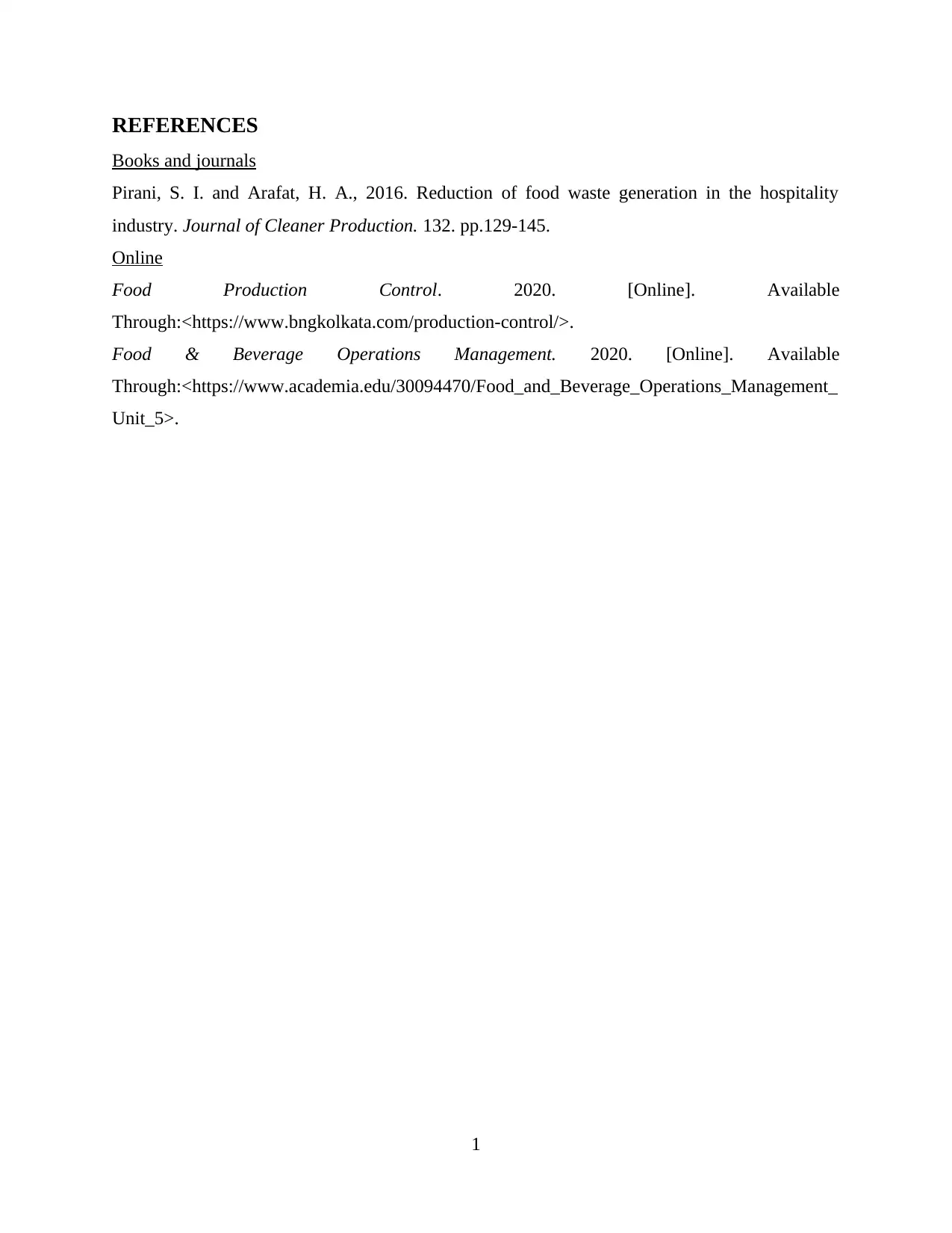
REFERENCES
Books and journals
Pirani, S. I. and Arafat, H. A., 2016. Reduction of food waste generation in the hospitality
industry. Journal of Cleaner Production. 132. pp.129-145.
Online
Food Production Control. 2020. [Online]. Available
Through:<https://www.bngkolkata.com/production-control/>.
Food & Beverage Operations Management. 2020. [Online]. Available
Through:<https://www.academia.edu/30094470/Food_and_Beverage_Operations_Management_
Unit_5>.
1
Books and journals
Pirani, S. I. and Arafat, H. A., 2016. Reduction of food waste generation in the hospitality
industry. Journal of Cleaner Production. 132. pp.129-145.
Online
Food Production Control. 2020. [Online]. Available
Through:<https://www.bngkolkata.com/production-control/>.
Food & Beverage Operations Management. 2020. [Online]. Available
Through:<https://www.academia.edu/30094470/Food_and_Beverage_Operations_Management_
Unit_5>.
1
⊘ This is a preview!⊘
Do you want full access?
Subscribe today to unlock all pages.

Trusted by 1+ million students worldwide
1 out of 6
Related Documents
Your All-in-One AI-Powered Toolkit for Academic Success.
+13062052269
info@desklib.com
Available 24*7 on WhatsApp / Email
![[object Object]](/_next/static/media/star-bottom.7253800d.svg)
Unlock your academic potential
Copyright © 2020–2025 A2Z Services. All Rights Reserved. Developed and managed by ZUCOL.




